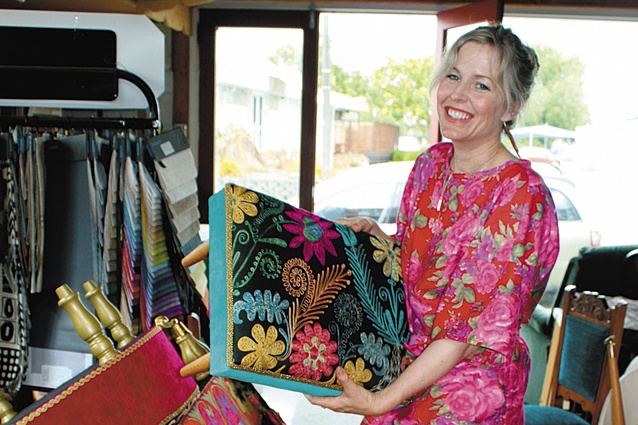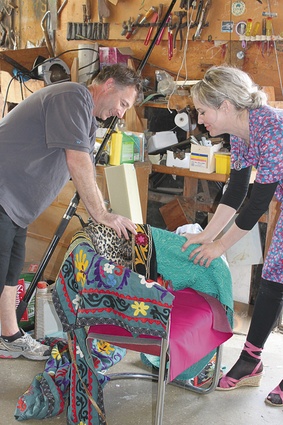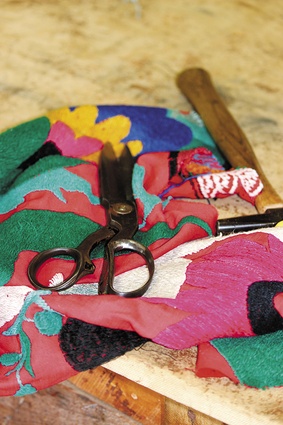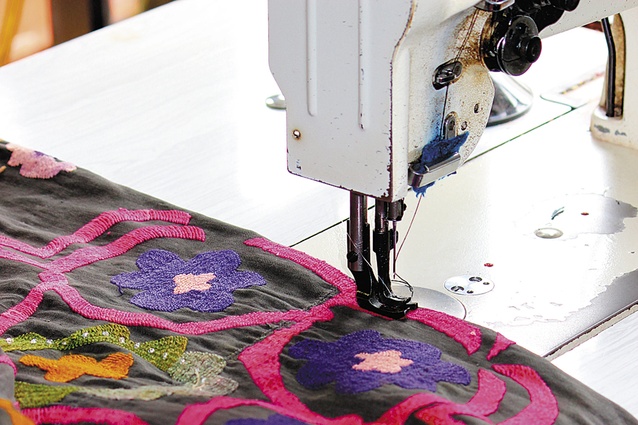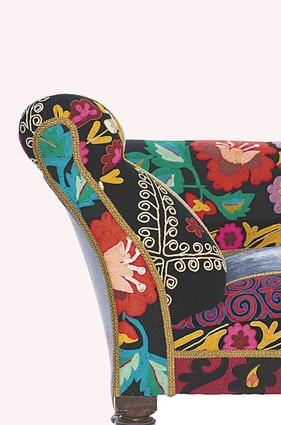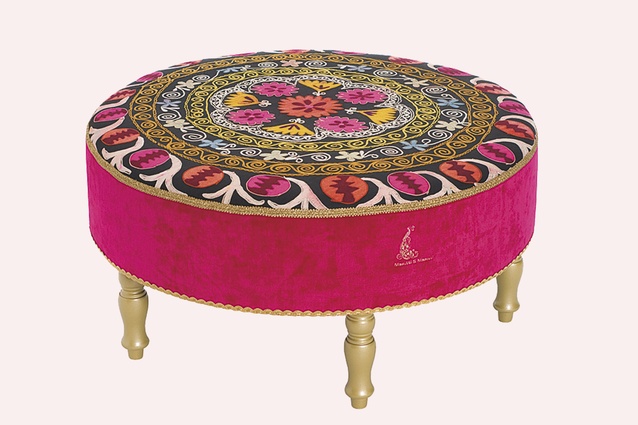Bright spark
If there’s one thing Angie Masutti’s not afraid of, it’s colour. With her husband Anton, the 42-year-old mother of three spends her working hours at the helm of Masutti & Masutti, transforming old bits of furniture into bespoke, brightly coloured statement pieces which are original and ever-so-vibrant. While Anton looks after the business and finances, Angie sources couches, chairs, lamps and stools – and the Asian embroideries she recovers them in – from her home in Pataua, near Whangarei. Urbis caught up with the entrepreneur for a chat about her colourful designs.
URBIS: What do you do?
Angela Masutti: Masutti & Masutti is all about reinventing vintage furniture and textiles. I recover and redesign old, forgotten furniture with beautiful vintage Central Asian embroideries and velvet. The furnishings we make are one-off statement pieces where function and form are in equal measure.
U: How did you learn to restore furniture?
AM: I have trained pretty much on the job. I started from an early age collecting vintage furniture and clothing, teaching myself how to strip and revive them. I have always preferred the old to the new, loved the patina and the idea of a previous, mysterious life. So my homes and wardrobes have always been full of vintage finds. And I rather compulsively read design magazines and books, continually educating myself on designers and design ideas.
U: How did that become a business for you?
AM: I was looking to furnish our newly renovated house with some great vintage pieces, but also wanted something more whimsical and bohemian. I had noticed some exotic-looking pieces in European design magazines and the breathtaking embroidered textiles also. Knowing there was no way to find anything in New Zealand like it, I took the kernel of the idea and designed a sofa for our home. After plenty of excited feedback, it didn’t take too much encouragement to develop the idea into a boutique design business. I work largely from home. I have an office in our sunroom, which is filled with embroideries, fabric samples, trims and lampshades. My desk and I squeeze into a corner. This is where I nut out my designs so it can get very chaotic. I often find myself spilling out into the living room as well. I also have a space at my upholsterer’s rather rumpty old workshop in town, where I keep much of my furniture, both completed and yet to be.
U: Where do the pieces come from?
AM: The furniture is sourced locally, within New Zealand, either online, through second-hand dealers, auctions and op shops and, as we are getting better known, people have begun contacting us about pieces they think we may like. Each piece is carefully chosen for its design, comfort and appeal; mid-century Scandinavian style like Saarinen is a favourite, but absolutely anything unusual is embraced. The vintage textiles are sourced from countries along the Silk Road with contacts we have there. I look for densely embroidered fabrics, as they are generally the most decorative and of better quality. The designs tell a traditional story and, whether they are nuptial curtains, prayer rugs, wall hangings, bedspreads, ceremonial robes, saddle blankets or tablecloths, each has a purpose.
U: What’s the process of reinventing them?
AM: The process for completing one piece is a lengthy and detailed one. It usually begins with sourcing the furniture. Then the piece is taken to pieces, any wooden parts are taken to the restorer to be sanded and oiled whilst I work with the parts to be upholstered. I sketch first to highlight and familiarise myself with the lines of the piece, then start looking at the fabrics and colour. I like to place random embroideries together with random colours and work them around till I come up with a mix that captivates me. We turn out several pieces a month including bespoke pieces. I use all local craftsmen to help make our pieces – three upholsterers, a lampshade maker, a turner, a restorer, a lacquerer and a seamstress. Recycling vintage pieces of furniture means that the actual design of the furniture is already there in front of you, and the same goes for the embroidery. The challenge then, which really inspires me, is to turn the two relatively conventional mediums into the unconventional – but in a beautiful way.
U: What inspires you to come up with your designs and combinations of fabric and furniture?
AM: Anton and I like the idea that we breathe a new design life into old and forgotten pieces of furniture and fabric. By marrying the disparate cultures and histories of the furniture and the textiles together, they are returned to life as functional, unique and useful art forms. We also find the sustainability of the recycling process this business involves is very satisfying. I like to create unexpected collaborations of colour and textiles, which have a certain harmony and balance together. It’s rather like the art of mismatching well.
U: What about role models? Who do you look up to in the world of furniture and interior design?
AM: I have so many designers I enjoy, many of them interior designers – like Kelly Wearstler for her unexpectedness, Tony Duquette for his lush staginess and good old Dorothy Draper for Hollywood glamour. Another of my favourite designers is Francis Sultana, a Maltese furniture designer. I love his art-deco-inspired pieces. A favourite New Zealand furniture designer is Todd Stevenson of Powersurge. I enjoy how he manages to makes steel look refined and inviting with his industrial take on Rococo style.
U: What one piece of furniture would you love to own?
AM: I would dearly love to own the Anita banquette by Francis Sultana. It is superbly glamorous, imminently inviting and looks rather like some kind of divine pet.
U: What’s coming up for Masutti & Masutti?
AM: Currently, we sell largely from our online store, but also have some pieces in Tuatara Design Store in Whangarei and Against the Grain in Tutukaka. In the future, we are looking at manufacturing our own furniture and have begun with some ottomans, which are custom-made to fit the actual size of the embroideries so no deconstruction is necessary. We are looking at designing a signature Masutti & Masutti chair also: something that has vintage appeal but with a contemporary – perhaps industrial – twist.

